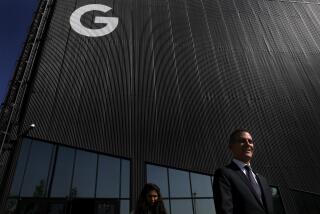Chatsworth Seeing Local Emergence of Fiber-Optic Firms
With two fiber-optics companies going public this month, and a third on the way early next year, Chatsworth is quietly emerging as a regional spawning ground for one of technology’s hottest growth sectors.
Today, shares of optical-components maker Luminent Inc., a spinoff of MRV Communications, will begin trading on Nasdaq under the symbol LMNE. The company late Thursday raised $144 million by selling 12 million shares at $12 each.
The Luminent initial public offering follows by one week the IPO for cross-town competitor Optical Communication Products Inc., which raised $115.5 million in its deal. On the first day of trading the stock soared 63%, climbing from $11 to $17.88. It closed Thursday at $16.88, down $1.50 on Nasdaq.
And MRV says that, in the first quarter of next year, it is planning a $108-million IPO for Optical Access, its wireless-products division, according to documents filed with the federal Securities and Exchange Commission. That San Diego-based company has offices in Chatsworth and could move there. It is now a wholly owned subsidiary of MRV Communications but separate from Luminent, company officials said.
MRV Chief Executive Noam Lotan declined to comment, citing the “quiet period” before Luminent’s public offering. But in an interview in the spring, he talked of his goal of creating an “optical empire.”
“Ultimately, we want to have fiber running to every home,” Lotan said.
While Silicon Valley continues to dominate the fiber-optics world with the presence of players like JDS Uniphase and Agilent, industry experts say these companies have a chance to flourish amid the ranch homes and business parks that make up the Northwest San Fernando Valley.
In all, more than 1,000 people are employed by the three companies in Chatsworth, designing, manufacturing and marketing components and other equipment for optical and wireless networks.
Once home to defense-related research and technology firms, Chatsworth has built on that legacy as a growing area for commercial-related communications and networking companies.
Many of the companies filled a vacuum left by California’s dwindling military-industrial complex. Remaining were an experienced crop of engineering talent, access to cheaper land as well as top-notch universities and research facilities.
“This is not a new story for Chatsworth,” said Rohit Shukla, vice president of the Los Angeles City Board of Information Technology Commissioners. “Chatsworth and the West Valley have been attractive to technology companies at least since the ‘70s.”
Where traditional communication networks relied on copper wires to distribute voice data, the growth of the Internet has unleashed an insatiable appetite for components to build broadband and high-speed networks.
To do that, communications firms have looked increasingly to fiber optics, which carry large amounts of data quickly by transforming electronic signals into light pulses.
“With local optics firms, they may not have been defense-related per se, “ said Greg Njeos, a consultant with technology companies for PricewaterhouseCoopers in Woodland Hills. “But as defense spending decreased, they have hired a lot of technical talent that left for the commercial ranks.”
Weighed against industry heavyweights such as Lucent Technologies, Nortel Networks and JDS Uniphase, Chatsworth’s optics companies are a relatively small slice of a $300-billion sector.
Still, industry analysts say there is plenty of room for smaller players, and that will grow amid demand for broadband and high-speed Internet connections.
Optical Communication, for example, makes fiber-optic components linking intrastate optics networks to metropolitan or “last-mile” telecommunications networks that link to individual homes and businesses.
Half of the company’s revenue comes from Cisco Systems and Alcatel--causing some risks if those customers were to cut spending, according to company documents filed with the SEC.
Still, the company--founded in 1991 by Japan’s Furukawa Electric, which still owns a 62% stake--is already turning a profit. The firm reported pro forma net income of $16.7 million for the second quarter ended June 30 on sales of $69.1 million. That was well ahead of the same quarter last year, when the company reported pro forma net income of $4 million on sales of $23 million.
Luminent is one of 14 companies--including Zaffire, Charlotte’s Networks, Hyporium and Zuma Networks--MRV is hoping to create in an effort to become an optics incubator.
Optical Access, MRV’s optical wireless business, would be the next public spinoff. That company was recently enlarged by MRV’s $159-million acquisition of AstroTerra Corp., a maker of free-space optical wireless technology, and Jolt, an Israeli-based wireless-optical firm for which MRV paid $60 million.
In part because of those costs, MRV reported a net loss of $74.4 million in the third quarter, compared with net income of $567,000 for the same period last year. Revenue rose 16% to $82.7 million.
MRV’s stock has reflected the topsy-turvy ride of the broader technology sector in 2000. The stock hit a high of $97.44 in March, plunged in spring, then rebounded to $80 by late summer--before tumbling again. It closed Thursday at $32.88, down $1.13 on Nasdaq.
MRV suffered a setback in the Luminent offering on Thursday: The company had hoped to raise as much as $15 a share in the IPO.
Worries over whether the strong demand for fiber-optic components may be slowing--even marginally--have hurt many larger fiber optic stocks in recent weeks such as Nortel and JDS Uniphase.
Like Optical Communication, Luminent depends on a few large companies, including Cisco and Marconi Communications, for much of its sales--about 45% now.
Luminent reported a loss of $10.9 million for the six months ended June 30. Company officials said the loss was due in part to the February acquisition of Fiber Optic Communications Inc. of Taiwan for $263 million in stock and cash.
The high risk involved in the business was noted in the firm’s IPO filing with the SEC.
“We have no history as an independent company and have only a limited history in the passive optical-components markets,” the document said. “These factors may make our business more difficult to evaluate and hinder our ability to implement our business plan.”
Ben Holmes, founder of ipoPros.com,, a Boulder, Colo.-based research group, said he doesn’t believe the prospects of near-term losses will dramatically dampen enthusiasm for Luminent’s IPO because of the company’s long-term growth potential.
“There will be buyers for it,” Holmes said. “The fact that a company isn’t profitable hasn’t stopped these deals from being done. These are volatile stocks. They have always been volatile stocks.”
Even with the growth of its optics firms, it’s doubtful that Chatsworth or the West Valley will reach the critical mass of optics firms that are centered in Northern California, says Jeff Montgomery, president of San Mateo Calif.-based Electronicast, a company that has tracked the optical-component market for almost two decades.
“The greatest activity in optical communications, in both components and equipment, is in the San Francisco Bay Area,” Montgomery said. “This is where there’s the most start-up activity, where people can find financiers, where they can find the people they need [to] expand and build upon themselves.”
Chatsworth may not be the Bay Area, but it offers great potential for a growing company at a lower cost, Njeos said.
“This area offers companies the full spectrum of infrastructure and people,” Njeos said. “And as for the bottom line, its simply a cheaper a place to do business.”
(BEGIN TEXT OF INFOBOX / INFOGRAPHIC)
The Other Valley
These three fiber-optic companies were spawned in Chatsworth:
Luminent Inc.
* Founded: MRV Communications subsidiary since 1998
* Employees: 1,040
* Product: Makes fiber-optic components for communications networks
* Sales: $65.3 million (1999)
* Net income: $4.2 million (1999)
Optical Communication Products Inc.
* Founded: 1991, went public
last week
* Employees: 291
* Product: Manufactures and sells fiber-optic components for metropolitan-area networks that link intrastate fiber-optic networks with those that provide service to businesses and residents
* Sales: $65.2 million (1999)*
* Net income: $1.9 million (1999)*
Optical Access
* Founded: Another MRV spinoff, December 1999
* Employees: 173
* Product: Makes wireless optical systems for “last-mile” network
* Sales: $10.9 million for six months ended June 30*
* Net income: Lost $46 million for six months ended June 30*
*Pro forma






